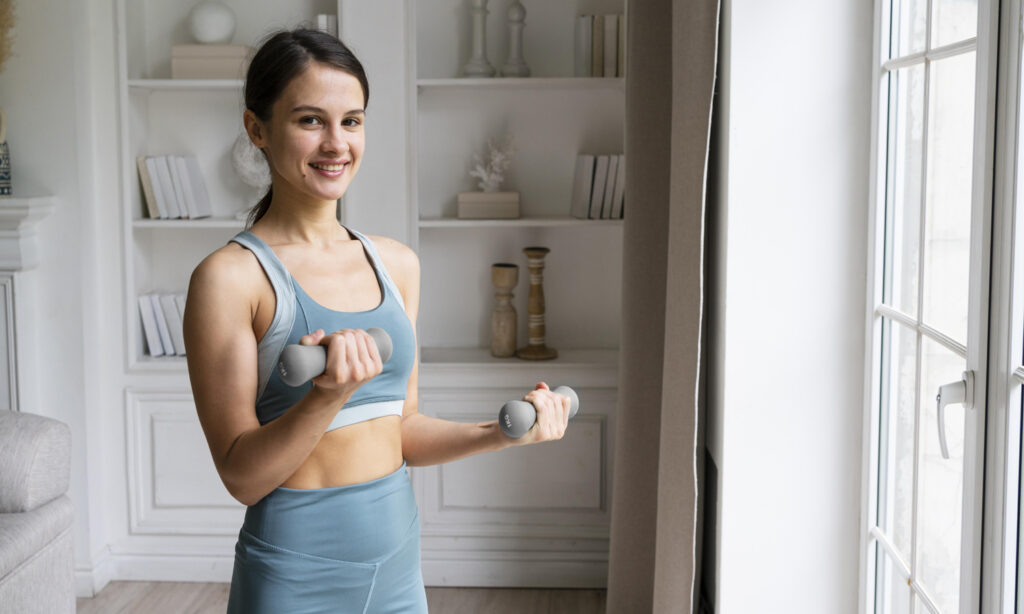Sick of hours of cardio with few results? What if dumbbell exercises for weight loss — the real secret — were sitting right in your living room? Those dumbbells aren’t only for toning arms; they are your shortcut to burning fat and building metabolically active muscle.
Unlike say, treadmill running, which creates a big calorie burn at the time of the workout, dumbbell exercises for weight loss do an extra service: They burn up calories when you’re sweating, and promote a faster metabolism for hours after your workout is done. Research has shown that results that combine strength training and fat loss (Journal of Applied Physiology) actually provide up to 2x more sustainable results than cardio alone. Plus, compound moves like squats and presses give you the most bang for your buck by hitting multiple muscles at the same time—ideal for a busy schedule.
In this post, you’ll learn:
- The 5 best dumbbell workout exercises to burn fat,
- How to create a 20-minute home routine (no gym necessary!),
- Why it’s pointless to do endless crunches if you want to slim down, the scientific way.
Dumbbells adjust to any environment, fitness level, or objective. It’s time to transform those underutilized tools into your secret super-sleuthers of weight loss.
Why Dumbbell Workouts Are Ideal for Weight Loss
Dumbbell exercises for weight loss aren’t just fads — they’re science-based. Resistance training through dumbbell workouts not only burns fat but also preserves lean muscle, which is critical for maintaining a higher metabolism, according to a study from Harvard Health. This is where weight training is different from steady-state cardio; weight lifting creates an EPOC (Excess Post-Exercise Oxygen Consumption) effect, and you continue to burn calories for up to 48 hours after your workout.
What’s The Afterburn Effect, In Simple Words?
EPOC is how your body recovers from vigorous exercise. Compound dumbbell moves (think squats, lunges, and presses) require more oxygen, energy, and muscle use than isolation moves do. This leads to a metabolic “debt” that requires your body to burn additional calories even while you’re bingeing on Netflix.
Which Prevails: Dumbbells or Machines or Bodyweight in the Battle of Fat Loss?
| Factor | Dumbbells | Machines | Bodyweight |
| Calorie Burn | High (EPOC boost) | Moderate | Moderate |
| Muscle Activation | Full-body | Isolated | Limited |
| Convenience | Home/gym friendly | Gym-only | No equipment |
| Progression | Easy (add weight) | Fixed resistance | Limited |
Dumbbells rule for versatility and metabolic impact.
The post 5 Reasons to Grab Dumbbells Right Now appeared first on Exercise.com.
- Builds light muscle: Muscle burns 3x more calories at rest than fat does (Healthline).
- Increases metabolism: EPOC adds another 6–15% of calories on top of normal expenditure after exercise.
- Full-body conditioning: Get a lot of muscles working in a single movement, like in thrusters or renegade rows.
- Customizable: Change weight, reps, and tempo to fit your individual fitness level.
- Space-efficient: Ideal for home workouts—no bulky machines required.
1. Dumbbell Goblet Squat: Your Secret Weapon for Fat Loss
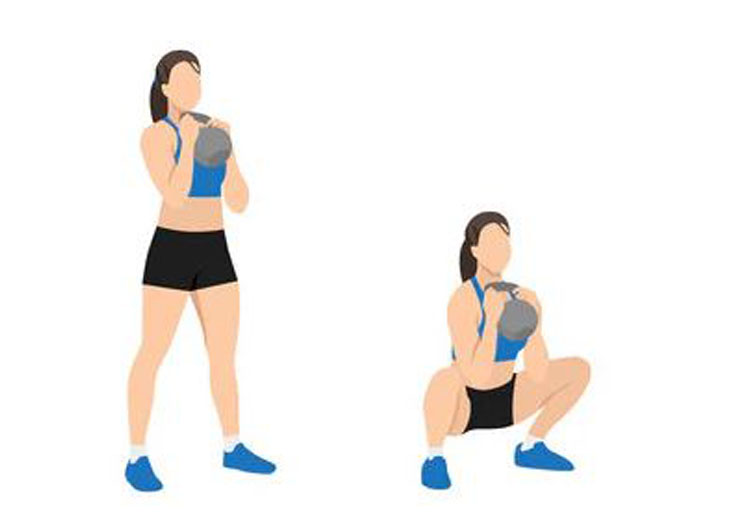
The dumbbell goblet squat is a key dumbbell exercise for weight loss, combining strength and cardio to blast fat and build lower-body power at the same time. That’s why fitness pros like ACE Fitness rank it one of the best functional exercises for metabolism-boosting results.
Muscles Worked
- Main Targeted: Quads, glutes, core
- Secondary: Hamstrings, shoulders, upper back
Why It Burns Fat
By working large muscle groups (hi, glutes!), this move elevates your heart rate, and press the afterburn effect, which burns calories long after you’ve finished working out. Research shows that compound movements — like goblet squats — can torch 50% more fat than isolation exercises
Step-by-Step Guide
- Grip: Hold a dumbbell vertically at chest level, with elbows tucked.
- Stance: Feet shoulder-width apart, toes pointed slightly outward.
- Squat: Hinge hips back, knees tracking over toes, until thighs are parallel to the ground.
- Drive Up: Press through heels, engaging glutes to rise back to standing.
Begin with a 3-second hold at the bottom or slow down the descent (tempo training) to increase muscle tension and calories burnt.
Common Mistakes to Avoid
- Leaning Forward: To act as a counterweight against objects, keep your chest upright to protect your lower back.
- Knee Collapse: Move knees away from the body, in line with toes.
- Shallow Squats: Squat deep enough to engage the glutes
Personal Insight: “On time-crunched days, I use goblet squats as a finisher — they fry my legs and get my heart rate up in 10-rep ranges.”
Goblet Squat vs. Other Squats: Calorie Burn
| Squat Variation | Calories Burned (10 mins) | Muscle Activation |
| Goblet Squat | 80–100 | High (full-body) |
| Bodyweight Squat | 50–70 | Moderate |
| Barbell Back Squat | 70–90 | High (legs-focused) |
2. Dumbbell Squat to Press: The Ultimate Fat-Burning Combo
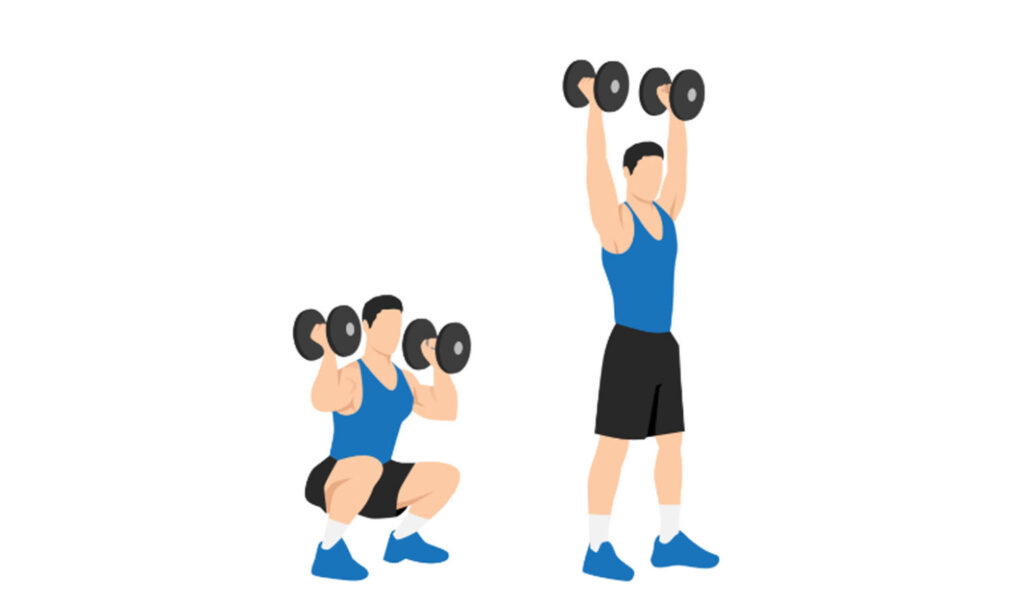
If you’re pressed for time but want the most bang for your buck in calories burned, the dumbbell squat to press is your go to. This full-body, compound movement, one of the best high-intensity return exercises, combines strength training with cardio into one explosive workout, making it one of the best dumbbell exercises for weight loss. Compound lifts like this burn 20–30% more calories than isolates, according to a Sports Medicine study, as they activate multiple muscle groups at once.
Why This Move Crushes Fat
- Total-body activation: Works quads, glutes, shoulders and core.
- EPOC boost: The combination of squatting and pressing raises the heart rate, causing Excess Post-Exercise Oxygen Consumption to occur for hours post workout, burning more calories.
- Functional strength: Mirrors everyday activities (like lifting groceries overhead), making it easier to move through
How To Master The Dumbbell Squat To Press
- STARTING POSITION: Hold dumbbells at shoulder height, elbows bent.
- Lower: Sink into a goblet squat, keeping your chest upright.
- Press: From where you are, press the weights overhead, arms fully extended.
- Return: Lower dumbbells back to shoulders with control.
Pro Tip: Apply a “tempo” (like 3 seconds down, 1 second up) to increase muscle tension and fat burn.
Common Mistakes
- Rounded Back: Maintain a braced core to safeguard your spine.
- Masked Press: Keep arms vertically overhead to make them work with the maximum range of motion
- Rushing: Take charge of the motion—momentum diminishes outcomes.
Variations to Spice It Up
- Single-Arm: Test balance as well as core stability.
- Switch Hands: Improve coordination and unilateral strength.
- Pulse Squat: Add a little pulse at the bottom for added glute fire.
Calorie Burn Comparison
| Exercise | Calories Burned (10 mins) | Muscles Targeted |
| Squat to Press | 90–120 | Full-body |
| Bicep Curls | 40–60 | Arms |
| Jumping Jacks | 70–90 | Cardio-focused |
3. Dumbbell Renegade Rows: Sculpt Your Back & Torch Fat

Dumbbell renegade rows are a sneaky fat-burner right in front of you. This dumbbell exercise for weight loss hits core stability, upper-body strength and metabolic conditioning, so it’s a triple threat for burning calories. According to ACEFitness, compound movements (like renegade rows) burn 25% more calories than isolated exercises because they involve multiple muscle groups at the same time.
Why Renegade Rows Melt Fat
- Muscles used: Lats, rhomboids (back), core, biceps, and shoulders.
- Posture benefits: Builds upper-back strength to combat slouching.
- Cardio: You’re in the plank position, which engages your core, making this a full-body metabolic drill.
Step-by-Step Form Guide
- Preparation: Position two dumbbells on the floor shoulder-width apart. Grab them; get into high plank, wrists under shoulders.
- Row: Pull one dumbbell toward your rib cage, elbow brushing your side. No twisting! Keep the hips square to the floor!
- Lower: With control, return the weight, and repeat on the opposite side.
Modifications For A Beginner: Try dropping to your knees or using lighter weights to build proper form first.
Common Mistakes to Avoid
- Hip rotation: Try to keep the hips parallel to the floor (same as balancing a glass of water on your lower back.)
- Rushed Reps: Take your time; focus on getting maximum time under tension rather than speed.
- Sagging Core: Tighten your abs as if someone is about to punch you.
Renegade Rows vs. Other Back Exercises
| Exercise | Calories Burned (10 mins) | Posture Benefits |
| Renegade Rows | 70–90 | High (core + back) |
| Bent-Over Rows | 50–70 | Moderate |
| Lat Pulldowns | 40–60 | Low |
Progression Tips
- Add a Push-Up: Row one arm before doing a push-up for extra intensity.
- Tempo Training: Lower the dumbbell over a 4-second period for increased time under tension
- Single-Arm Holds: Hold a single dumbbell in a row position, all while staying in a plank position.
4. Dumbbell Deadlifts: The Overlooked Fat-Loss Power Move
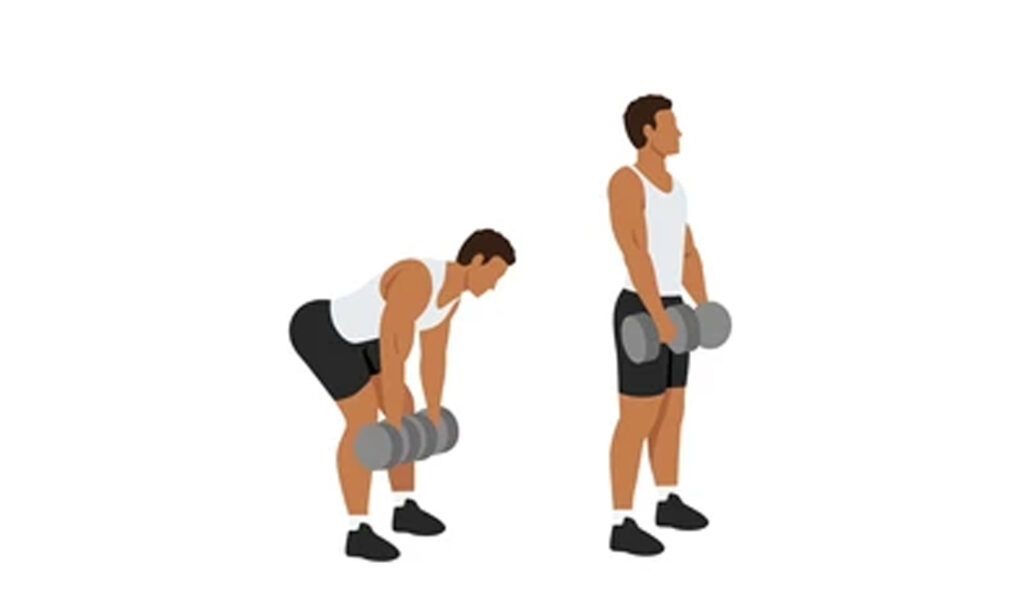
Dumbbell deadlifts are the Swiss Army knife of dumbbell exercises for weight loss, blasting your posterior chain (glutes, hamstrings, lower back) to incinerate calories and develop functional strength. According to Healthline, posterior-chain training burns 30 percent more calories than upper-body movements thanks to the size of involves muscle groups. But most lifters avoid them for flashier moves — don’t make that mistake!
Why Deadlifts Crush Fat
- Higher calorie burn: Big muscles = more calories burned.
- EPOC boost: The hip hinge motion requires huge effort, driving post-workout calorie
- Better posture: Strengthens the lower back and core to fight desk-slump syndrome.
Mastering the Hip Hinge
- Setup: Feet hip-width apart, stand with dumbbells in front of thighs.
- Hinge: With hips pushed back and knees slightly bent, lower weights along shins. Keep back flat!
- Drive: Pushing through heels into standing, allowing dumbbells to graze thighs.
Pro Tip: To master the hinge motion Brahimi recommends picturing that you’re shutting a car door with your hips.
Common Mistakes
- Rounding the Back: Keep a neutral spine to prevent injury.
- Shallow Hinge: Hinge forward until you feel a hamstring stretch (not past knees).
- Utilising Momentum: You bloody control that movement — no swinging!
Trainer Tip: “I program dumbbell deadlifts for clients who are sitting all day—they correct posture and torch belly fat.”
Variations of the Deadlift to Lose Fat
- Romanian Deadlifts (RDLs): Target hamstrings with limited movement.
- Stiff-Leg Deadlifts: Deeply stretch and strengthen hamstrings.
- Single-Leg Deadlifts: Increase balance and unilateral power.
Comparison of Deadlifts: Effects on Weight Loss
| Type | Calories Burned (10 mins) | Muscle Emphasis |
| Dumbbell Deadlift | 80–100 | Glutes, hamstrings, core |
| RDL | 70–90 | Hamstrings, lower back |
| Conventional | 90–110 | Full posterior chain |
Beginner-Friendly Tips
- Use lighter weights to perfect your form.
- Use a mirror to see spinal alignment.
- Do deadlifts with rows or squats in circuits to burn fat all over your body.
5. Dumbbell Chest Press: Upper-Body Power Meets Core Stability
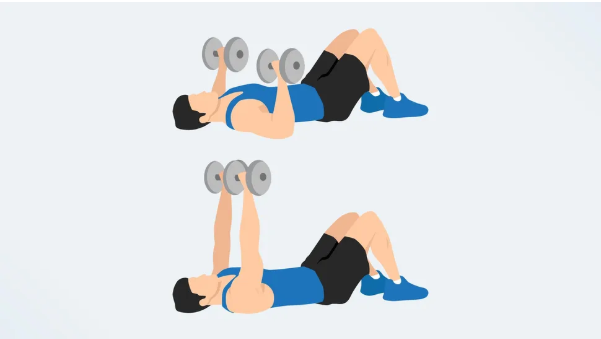
Assume chest workouts are solely for increasing muscle? Think again. If you’re looking for dumbbell exercises for weight loss, the dumbbell chest press is a sneaky fat-remover because it integrates upper-body weight training with core engagement to increase the calories burned. Compound pushing movements like this one can raise heart rate by 20–30% compared with isolation exercises, according to ACE Fitness, making them great metabolic conditioning options.
The Importance of Pushing Movements for Fat Loss
- Countermeasures pulling strength: Helps maintain muscular balance to counteract pulling activity (ex: rows).
- Core activation: If you do this on the floor or a stability ball, your abs are also working overtime to keep your body stable.
- Calorie burn: Muscles that cover a larger area of the body (chest, shoulders, triceps) require more energy, making them an efficient fat burn.
Perfecting Your Form
- Set-up: Lie on a bench, floor or stability ball. With dumbbells directly above shoulders, palms facing forward.
- Grip: Maintain neutral wrists (not bending back).
- Lower: Bend elbows to 90 degrees, lowering weights until elbows gently touch ground/bench.
- Press: When you press them up, their weights get heavier, compressing your chest muscles at the apex.
Pro Tip: When on a stability ball, flex your glutes and abs to eliminate wobbling — this doubles calorie burn!
Common Mistakes
- Elbow Flare: Keep elbows at 45 degrees to protect shoulders.
- Arching Back: If you’re using a bench, press your hips upward toward the ceiling to help alleviate strain on the lower back.
- Momentum: Lower and lift weights slowly — no bouncing!
Trainer Insight: “I like to do chest press and renegade rows in superset style so I can keep my heart rate spiked. Brutal fat-loss combo! …”
Fat-Burning Superset Idea
- Dumbbell Chest Press: 12 reps ·
- Renegade Rows: 10 reps/side
Rest 30 seconds; repeat 4x.
This twosome works the upper-body muscles while revving your metabolism.
Floor Press Tips: Your At-Home Workout Hack
No bench? No problem. The floor press (lying flat) is restrictive for range of motion but provides more stability, making your core and triceps work harder. Perfect for small spaces!
Chest Press vs. Other Upper-Body Moves
| Exercise | Calories Burned (10 mins) | Muscles Targeted |
| Chest Press | 60–80 | Chest, shoulders, triceps |
| Push-Ups | 50–70 | Chest, core |
| Bicep Curls | 30–50 | Arms |
6. Dumbbell Lunges: Fire Up Your Metabolism with Single-Leg Strength
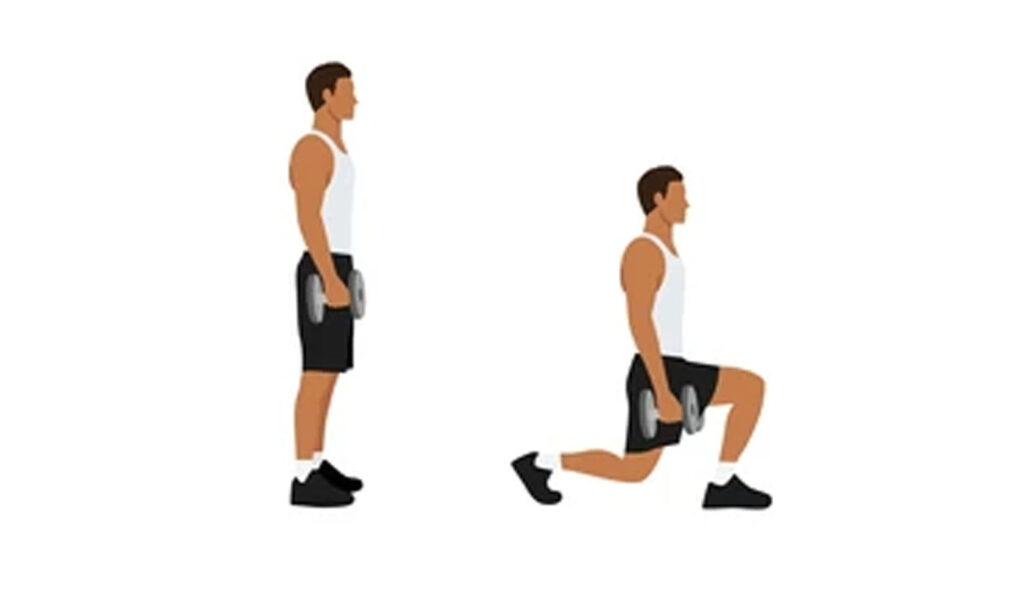
Dumbbell lunges aren’t just total leg day staples — they also happen to be calorie-incinerating powerhouses in dumbbell exercises for fat loss. This single-leg move challenges your body to work harder because of unilateral loading, leading to 20–25% higher caloric burn than bilateral moves such as squats, per ACE Fitness. By challenging balance and targeting the glutes, quads, and hamstrings, lunges can transform your lower body into a fat-burning furnace.
Why Lunges Crush Fat
- Demand on metabolism: Performing one leg at a time increases the energy exertion.
- Muscle activation: Works the stabilizing muscles for functional strength.
- EPOC benefits: Intense variations of the lunge raise your metabolism after your workout.
4 Types of Dumbbell Lunges
- Forward Lunge: Step forward and lower until both knees are at 90 Best for beginners.
- Reverse Lunge: Step back to ease knee pressure. Easier on joints.
- Walking Lunge: Step forward into a lunge repeatedly—great for cardio intervals.
- Lateral Lunge: Step to the side, stressing the inner thighs and glutes
Common Form Errors (And How to Fix Them)
- Leaning too far forward: Keep your torso upright; picture a string pulling your head upward.
- Knee Collapse: Knees should be pushed outward, aligned with the toes.
- Shallow Lunges: Sink until your back knee hovers 1 inch above the
PRO TIP: Place your rear foot on a step to enhance the stretch and ensure greater glute activation.
Lung variations by difficulty
- Novice: Reverse Lunges, Static Lunges
- Intermediate: Walking Lunges | Lateral Lunges
- Advanced: Deficit Lunges, Jumping Lunges
Calorie Burn Comparison
| Lunge Type | Calories Burned (10 mins) | Intensity |
| Walking Lunges | 70–90 | High |
| Reverse Lunges | 50–70 | Moderate |
| Lateral Lunges | 60–80 | Medium-High |
7. Dumbbell Russian Twists: Torch Calories & Sculpt Your Core

Dumbbell Russian twists are a double whammy: they carve you up obliquely and also crank up your blood rate — a dumbbell workout for weight loss that deserves single-dumbbell treatment. Dynamic core movements, such as twists, can help you burn 8–10 calories per minute at high intensity, according to research from ACE Fitness—approximately the same as traditional cardio.
Why Russian Twists Burn Fat
- Core + cardio combo: Pacey twists to activate your obliques and build your heart worth it up for metabolic conditioning.
- Functional strength: Enhances rotational power, which is crucial for sports and daily activities
- EPOC boost: The high-intensity intervals create post-exercise calorie burn.
Step-by-Step Form Guide
- Setup: Sitting on the floor with the knees bent and the heels lifted. Grasp a dumbbell with both your
- Lean Back: Tuck in your core, lean back at a 45-degree angle.
- Twist: Rotate shoulders to touch the dumbbell beside your hip, then switch sides.
- Inhale: Brace your core and maintain balance in the pose.
Pro Tip: Stay proud with your chest and don’t round your spine—think balancing a book on your head!
Weighted or Bodyweight: Who Burns More?
| Version | Calories Burned (10 mins) | Intensity |
| Weighted | 80–100 | High |
| Bodyweight | 50–70 | Moderate |
Holding a dumbbell makes your core engage more intensely, with 30–40% greater caloric expenditure (Journal of Sports Science).
Metabolic Training Hack
Swap reps for timed sets:
- 30 seconds: Weighted max twisting
- 15 seconds: Rest
- 8x–only 6-minute core shredder.
Common Mistakes
- Momentum versus Control — Slow Down! Quality > speed.
- Feet Flat on Floor: Raise heels to work deeper core muscles.
- Shallow Twists: Go around 360 degrees to increase engagement in the obliques.
8. Dumbbell Hip Thrust: Ignite Your Glutes & Supercharge Fat Loss
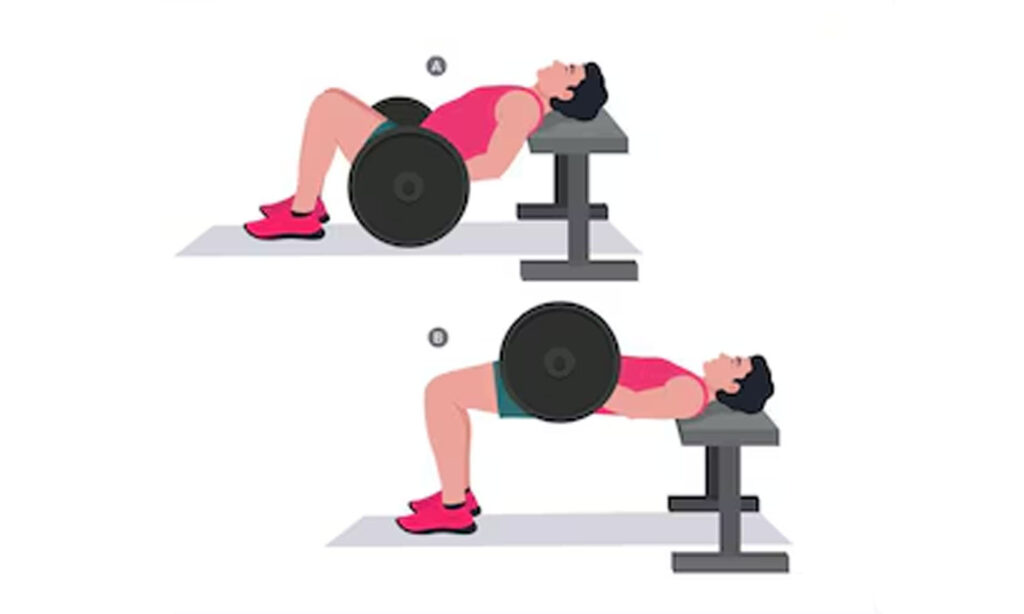
The dumbbell hip thrust isn’t only for sculpting a stronger behind—it’s a metabolic game-changer among dumbbell exercises for weight loss. This move not only revs up calorie burn, targeting the largest muscle groups in your lower body (the glutes and hamstrings), but also tones you into a lean machine. Hip thrusts can burn 8–12 calories per minute, ACE Fitness says, and when performed at a high intensity, may burn as much or more than traditional cardio.
Why Hip Thrusts Crush Fat
- Metabolic component: Big muscle groups need tons of energy, which means they burn off calories long after the workout is over.
- Glute activation: Powerful glutes improve posture, decrease lower back strain, and increase athletic performance.
- Versatility: Scalable enough for a beginner or an advanced lifter.
Step-by-Step Setup
- Position: Sitting on the floor, upper back against the bench. Rest a dumbbell on your hips (use a towel for comfort).
- Feet: Funnel feet hip-width apart, knees bent at 90 degrees.
- Thrust: Using heels, drive up, lifting hips until body forms a straight line from shoulders to knees. Squeeze glutes at the top!
- Lower: Free return with control
Pro Tip: You don’t want to strain your neck, so keep your chin tucked and press through your heels.
Avoid Lower Back Strain
- Engage core: Like you’re preparing to catch a punch to the stomach, tighten your abs.
- Decrease Variability: If you have back discomfort, lower hips only halfway.
- Bench Height: A 12–16-inch bench is appropriate—anything higher will transfer tension into your lower back.
Trainer Insight: “Including hip thrusts in your clients’ training routines helps shed hip fat even faster—it’s a furnace for glute building!”
Advanced Variation: Single-Leg Hip Thrust
- With the grounded foot, lift one leg straight out, thrusting.
- Makes it 40% harder and fixes muscle imbalances.
Hip Thrust vs. Other Lower-Body Moves
| Exercise | Calories Burned (10 mins) | Glute Activation |
| Hip Thrust | 80–120 | High |
| Squats | 70–100 | Moderate |
| Lunges | 60–90 | Moderate-High |
9. Dumbbell Step-Ups: Power, Balance & Fat Burn in One Move
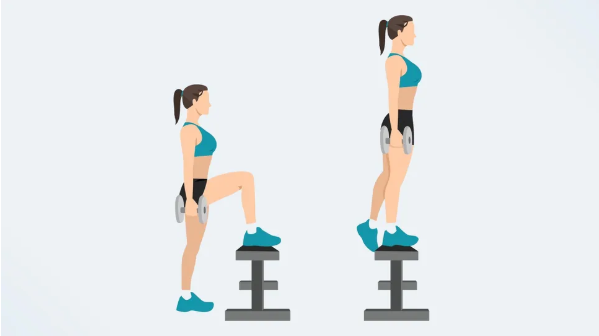
Tired of the stair climber? Fat burning secret number 6: Dumbbell step-ups, 2x the calorie burn in half the time! Combining strength, balance, and cardio, this move works your glutes, quads, and core while keeping your heart rate through the roof. Research by ACE Fitness explains that step-ups can burn 100–150 calories in as little as 10 minutes, if done at high intensity, beating out running!
Why Step-Ups Crush Fat
- Unilateral power: Doing one leg at a time corrects muscle imbalances and boosts energy expenditure.
- Metabolic conditioning: The brevity and rapidity of the sets in the Metcon phase elevate the excess post-exercise oxygen consumption or EPOC, increasing the calories burned hours after the workout ends.
- Functional fitness: It replicates real-life movements (stairs, hiking, etc.) for practical strength.
Step-by-Step Form Guide
- Setup: Stand facing a working bench/box (12–24 inches), dumbbells at sides.
- Step Up: Drive through your heel as you step up onto the bench, keeping torso vertical.
- Knee Drive: For added core engagement, drive your back knee toward your chest.
- Lower: Carefully lower yourself to the ground.
Pro Tip: Include a 2-second hold at the top to negate inertia and ensure glutes are doing the bulk of the work.
Common Mistakes
- Rush: Don’t rush, you want control—no bouncing and no lunging
- Leaning Forward: Maintain a lifted chest to protect the lower
- Partial Range: Keep your foot fully hip pinned to unroll the bench.
Scale Your Intensity
| Box Height | Calories Burned (10 mins) | Difficulty |
| 12 inches | 80–100 | Beginner |
| 18 inches | 100–130 | Intermediate |
| 24 inches | 130–160 | Advanced |
Fat-Burning Circuit Idea
- Dumbbell Step-Ups: 10 reps/side
- Renegade Rows: 8 reps/side
- Thrusters: 12 reps
Rest 20 seconds; repeat 4x.
This combo launches 200–300 calories in 20 minutes (for a 155-lb person).
How to Monitor Your Progress and Stay Consistent
Dumbbell exercises for weight loss work, provided you follow through consistently. But measuring success beyond the scale — how does that or what does that mean? Let’s go over science-backed methods to track progress, smash plateaus, and maintain motivation.
Use Fitness Apps or Journals
- Apps: Apps such as Strong or MyFitnessPal allow you to record weights, reps, and workouts. Progressing from a 15lb to a 25lb dumbbell squat? That’s progress!
- Journals: Older-style notebooks will do just fine. Make a note of how you feel — e.g., “Today’s 3×12 goblet squats felt easier!”
Set SMART Goals
Translate abstract goals into concrete targets:
- Specific: “Add 10% to dumbbell deadlift max in 4 weeks.”
- You can measure it: reps/weight, weekly.
- Attainable: Begin with 5lb
- Relevant: Ties in with fat loss (e.g., “Add 2 rounds to my dumbbell circuit.”)
- Time-bound: *“By Month 2, master single-leg hip thrusts.” *
Celebrate Non-Scale Victories
Weight loss isn’t linear. Celebrate these wins:
- Using heavier dumbbells for sets over 12 reps.
- Getting into jeans without panty digs.
- Finishing a HIIT circuit without gasping.
Personal Insight: “Back to work with some beautiful goals. The scale didn’t move, but her confidence did!!!”
Avoid Plateaus
Stuck? Mix your dumbbell exercises for weight loss:
- Change Variables: Go heavier, shorter breaks (e.g., 30s → 20s), or switch moves (e.g., one-arm presses).
- Mix Intensity: Replace steady reps with HIIT intervals.
- Nutrition check: Are you fueling recovery?
All About Progressive Overload
| Method | Example |
| Increase Weight | Switch from 15lb to 20lb dumbbells. |
| Add Reps | Go from 10 → 12 thrusters per set. |
| Adjust Tempo | Slow squats (4 seconds down). |
Progressive overload has been shown to increase fat loss by 15–20% in studies.
Dumbbell Training For Fat Loss: Common Myths
Let’s cut through the noise. Misinformation regarding dumbbells and fat loss is rampant, and as a result, many are condemned to walking on a treadmill as opposed to a weight area. Time to expose the science and sass behind the top myths!
Myth 1: “Weightlifting Makes You Bulky”
The Truth:
- Like a hormone: To pack on “bulky” muscle, you need high levels of testosterone, which in women is 15–20x lower than in men (Healthline).
- Training style: Dumbbell-based weight loss exercises (high reps, moderate weight) develop lean muscle, not size — toned arms, not
- Reality check — women put on muscle at a maximum of 1lb/ month. You won’t get “huge.” You’ll get “stronger.”
Myth Cart 2: “Cardio Is Better for Fat Loss”)
The Truth:
- Afterburn effect: A 2023 paper in the journal Obesity Reviews found that resistance training (for example, dumbbell workouts) raises post-exercise calorie burn 40% longer than cardio.
- Increased metabolism: Muscle burns 6–10 calories per day per pound (2–4 per kg), while fat burns a mere 2–3. Muscle = calorie torching 24–7.
- Body composition: Cardio makes you smaller; weights make you different. Have you ever met a “skinny-fat” runner? Exactly.
Cardio vs. Dumbbell Training: Fat Loss Face-Off
| Factor | Cardio | Dumbbell Workouts |
| Calories Burned | Higher during | Higher after (EPOC) |
| Muscle Retention | Low (can lose muscle) | High (builds muscle) |
| Time Efficiency | 45+ mins/session | 20–30 mins/session |
Myth 3: “Dumbbells Won’t Help You Lose Belly Fat”
The Truth:
- Spot-reduction is fake news, but compound lifts (thrusters, deadlifts, etc.) do burn visceral fat. According to a 2022 study, resistance training is associated with a 7% reduction of belly fat in 12 weeks (Harvard Health)
- Core focus: Moves like renegade rows and goblet squats engage your abs while burning calories.
The Bottom Line: Why Dumbbells Could Be Your Weight-Loss Best Friend
Let’s be honest: fitness trends are here today, gone tomorrow. But dumbbells? They’ve been smashing weight-loss goals for decades — and science just caught up to them.
The Dumbbell Advantage
- Versatility: Dumbbell exercises for weight loss easily adapt to any space, fitness level, or goal, from goblet squats to renegade No gym? No problem.
- Strength + Fat Burn: Cardio-only routines lack the high-light resistance dumbells develop metabolically active muscle. Only 1lb of muscle = 50+ more calories burned each day (ACE Fitness).
- Long-lasting results: A 2023 study showed that people who do both strength training and cardio lose 2x as much fat and keep it off longer (Obesity Reviews)
Start Small, Think Big
You don’t need a garage full of equipment or 90-minute workouts. Here’s how to begin:
- Choose 3 Moves: How about thrusters, lunges and renegade rows.
- Light: This can range from 5–10lb dumbbells
- Consistency is Key: 20 Min x 3 Sessions/Week = New You in 8 Weeks
- My Turning Point: “Last year I replaced long sessions on the treadmill with dumbbell circuits. Not only lost 12lbs, but finally have energy to play with my kids after work.”
Your Next Steps
- Share Your Story: What’s your favorite dumbbell exercise? Tell us in the comments!
- Try the Workout: Browse the sample circuit and tag us with your results.
- Stay Curious: Sign up for your weekly dose of tips like “5-Minute Dumbbell Finishers” or “Get Past Training Plateaus with Progressive Overload.”
Progress Over Perfection
| Week 1 | Week 8 |
| 10lb goblet squats | 20lb goblet squats |
| 5 push-ups | 15 push-ups |
| 30s plank | 90s plank |
Small wins add up. Celebrate them all.

